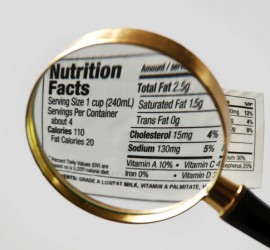
Photo: Shutterstock
Surveys show that most people want to make healthy food choices, but that isn’t always easy, especially when it comes to the pre-processed and packaged food that fills store-shelves these days. Packaged food, such as frozen or canned meals, or basically any food that comes in a cardboard box, can or plastic container, is now a part of our daily lives and will continue to be until some global calamity destroys all the factories. Until then, a key step towards making better food choices is to be able to understand nutritional labels on packaged food. This becomes even more important if you are shopping for your family and children, since the nutrition they get while young will affect them for the rest of their lives.
To start with, don’t just go by brands’ claims of being healthy and marketing tricks. For example, the package may say “fortified with vitamins” or “packed with proteins”, yet contain very few additional vitamins or proteins. A company may claim that something is “made with whole wheat”, suggesting that it contains healthy, complex carbohydrates. However, it may contain only a small percentage of whole wheat with the rest made up of simple carbohydrates such as bleached flour (maida). Similarly, a “low-fat” product may be packed with sugar and salt to compensate for taste.

The Food Safety and Standards Authority of India sets labeling requirements for packaged food in India.
Fat and sugar aren’t the only values that you need to be wary of; sodium, most commonly found in salt, can have a major effect on health when it comes to heart disease or high blood pressure. Unfortunately, packaged foods, especially snacks such as chips, pretzels and popcorn, are often stuffed with sodium, and many brands fail to even mention the content on their labels. Sodium disclosure is not required by FSSAI. The World Health Organization strongly recommends consuming less than 2g of sodium (less than 5g of salt) for adults and substantially less for children. A good goal would be to consume less than 1.5g per day, which is easier said than done.
For essential nutrition items, such as vitamins and minerals, it will be difficult to know how much is enough, especially since sometimes the units are milligrams or even micrograms. See if the nutrition label instead or also mentions what percentage of the daily recommended dose is contained in a portion. Again, consider how much you are likely to eat. Don’t get fooled by empty claims that some so-called health food manufacturers make. For instance, a granola bar could boast high vitamin and mineral value but also be loaded with sugar and fat. You’d be better off buying fresh or dried fruit, nuts and vegetables to get those important nutrients.
Finally, don’t forget to check protein content. The more protein a food has, the better it is. It is recommended that snacks for kids contain at least 15% of its total calories from protein. One simple way to figure out if a food has enough protein is to take the number of kcals per 100 grams, divide that number by 100 and multiply by 4. If the food has this amount of proteins, it is meeting the requirement. For example, if a food provides 600 kcals of energy per 100 grams, 100g should also contain at least 24g of protein. Going by this rule should help you choose better food with higher nutritive value.
Share your thoughts, leave a comment below. Please like FamiLife’s page on Facebook so that you get all our articles and others may find us.
